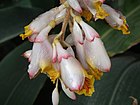Note: This is a project under development. The articles on this wiki are just being initiated and broadly incomplete. You can Help creating new pages.
Elettaria cardamomum - Ela, Cardamom
Elettaria cardamomum, commonly known as green or true cardamom, is a herbaceous perennial plant in the ginger family, native to southern India. It is the most common of the species whose seeds are used as a spice called cardamom. It is cultivated widely in tropical regions and reportedly naturalized in Réunion, Indochina and Costa Rica.
Contents
- 1 Uses
- 2 Parts Used
- 3 Chemical Composition
- 4 Common names
- 5 Properties
- 6 Habit
- 7 Identification
- 8 List of Ayurvedic medicine in which the herb is used
- 9 Where to get the saplings
- 10 Mode of Propagation
- 11 How to plant/cultivate
- 12 Commonly seen growing in areas
- 13 Photo Gallery
- 14 References
- 15 External Links
Uses
indigestion, nausea, vomiting, pulmonary disease, stomach pain, heart burn, throat troubles, congestion of the lungs, kidney stones
Parts Used
Chemical Composition
a-pinene, b-pinene, sabinene, myrcene, a-phellandrene, limonene, 1,8-cineole, y-terpinene, p-cymene, terpinolene, linalool, linalyl acetate, terpinen-4-oil, a-terpineol, a-terpineol acetate, citronellol, nerol, geraniol, methyl eugenol and trans-nerolidol[1]
Common names
| Language | Common name |
|---|---|
| Kannada | Elakki |
| Hindi | Elaichi |
| Malayalam | Elatarri |
| Tamil | Elam Ancha |
| Telugu | Elaki |
| Marathi | NA |
| Gujarathi | NA |
| Punjabi | NA |
| Kashmiri | NA |
| Sanskrit | Trutih |
| English | Cardamom, Malabar cardamom |
Properties
Reference: Dravya - Substance, Rasa - Taste, Guna - Qualities, Veerya - Potency, Vipaka - Post-digesion effect, Karma - Pharmacological activity, Prabhava - Therepeutics.
Dravya
Rasa
Katu (Pungent), Madhur (Sweet)
Guna
Laghu (Light), Ruksha (Dry)
Veerya
Sheet (cold)
Vipaka
Katu (Pungent)
Karma
Kapha, Vata
Prabhava
Habit
Identification
Leaf
| Kind | Shape | Feature |
|---|---|---|
| Simple | long and sword-shaped | The underside is paler and may have a covering of tiny hairs and it is Dark green |
Flower
| Type | Size | Color and composition | Stamen | More information |
|---|---|---|---|---|
| Unisexual | Reach over 1 m in length | pale green | 5-20 | the flowers contain both male and female parts. One of the petals is white and streaked with violet |
Fruit
| Type | Size | Mass | Appearance | Seeds | More information |
|---|---|---|---|---|---|
| oval-shape | Each fruit has three chambers filled with small aromatic seeds, each about 3 mm long | The fruits dry to a straw-brown colour and are widely used as flavouring | seeds dry to a straw-brown colour and are widely used as flavouring | {{{6}}} |
Other features
List of Ayurvedic medicine in which the herb is used
- Vishatinduka Taila as root juice extract
Where to get the saplings
Mode of Propagation
How to plant/cultivate
Cardamoms do not do well when exposed to draughts, sudden changes of temperature or direct sunlight[3]
Commonly seen growing in areas
semi-tropical, indoors in a heated greenhouse, warm shady humid place.
Photo Gallery
References
External Links
- Pages that are stubs
- Ayurvedic Herbs known to be helpful to treat indigestion
- Ayurvedic Herbs known to be helpful to treat nausea
- Ayurvedic Herbs known to be helpful to treat vomiting
- Ayurvedic Herbs known to be helpful to treat pulmonary disease
- Ayurvedic Herbs known to be helpful to treat stomach pain
- Ayurvedic Herbs known to be helpful to treat heart burn
- Ayurvedic Herbs known to be helpful to treat throat troubles
- Ayurvedic Herbs known to be helpful to treat congestion of the lungs
- Ayurvedic Herbs known to be helpful to treat kidney stones
- Herbs with Seed used in medicine
- Herbs with Fruits used in medicine
- Herbs with common name in Kannada
- Herbs with common name in Hindi
- Herbs with common name in Malayalam
- Herbs with common name in Tamil
- Herbs with common name in Telugu
- Herbs with common name in Sanskrit
- Herbs with common name in English
- Habit - Herb
- Index of Plants which can be propagated by Seeds
- Index of Plants which can be propagated by Cuttings
- Herbs that are commonly seen in the region of semi-tropical
- Herbs that are commonly seen in the region of indoors in a heated greenhouse
- Herbs that are commonly seen in the region of warm shady humid place
- Herbs









